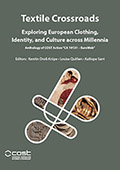Center, Textile Research

Textile Crossroads: Exploring European Clothing, Identity, and Culture across Millennia
Date of this Version
2024
Document Type
Article
Citation
In Textile Crossroads: Exploring European Clothing, Identity, and Culture across Millennia. Anthology of COST Action “CA 19131 – EuroWeb”. Kerstin Droß-Krüpe, Louise Quillien, & Kalliope Sarri, Editors. Zea Books, Lincoln, Nebraska, 2024. DOI: 10.32873/unl.dc.zea.1809
Abstract
Textiles as man-made products have been exchanged over distances for millennia. They can and have been produced almost anywhere; they are also, as a product, highly differentiated and quickly adjustable to changing demands. This brings with it naming practices to communicate about the goods in question. Textiles are labeled so that people can form expectations about them and rely on the reputation tied to the product’s identity. The terminology of textiles and textile items arises and develops in unison with technical innovations, discoveries, fashions, and trade patterns. Although the occurrence of toponyms e.g., in preindustrial trade (10th to 18th century AD) is widely used to study the development of textile trade, there are no studies that look at textile labeling practices across time and space in Europe’s history. This paper explores textile labels from Antiquity up until now, drawing on the expertise of an interdisciplinary group of scholars. Exploring labeling practices is worthwhile, as it allows us to better understand textiles as a phenomenon that has, across time, always connected regions, markets, and, not least, people. The discussion of naming practices of textiles, and especially the use of geographical indications (toponyms), is by no means only relevant to the study of the past as EU regulations show, namely the Geneva Act of the Lisbon Agreement of 2015, that defines appellation of origin as “any denomination protected in the Contracting Party of Origin consisting of or containing the name of a geographical area, or another denomination known as referring to such area, which serves to designate a good as originating in that geographical area, where the quality or characteristics of the good are due exclusively or essentially to the geographical environment, including natural and human factors, and which has given the good its reputation; as well as any indication protected in the Contracting Party of Origin consisting of or containing the name of a geographical area, or another indication known as referring to such area, which identifies a good as originating in that geographical area, where a given quality, reputation or other characteristic of the good is essentially attributable to its geographical origin.”
Included in
Ancient History, Greek and Roman through Late Antiquity Commons, Archaeological Anthropology Commons, Classical Archaeology and Art History Commons, Classical Literature and Philology Commons, Eastern European Studies Commons, European History Commons, European Languages and Societies Commons, Fiber, Textile, and Weaving Arts Commons, History of Science, Technology, and Medicine Commons, Human Geography Commons, Museum Studies Commons, Place and Environment Commons, Social and Cultural Anthropology Commons, Women's Studies Commons


Comments
Copyright © 2024 by the authors.
This paper brings together the presentations that comprised the EuroWeb seminar “What’s in a Name? Toponyms and loanwords as textile labels across time”, which took place in Braga at Minho University from 29th June–2nd July 2022, and was financed by COST Action CA 19131, supported by COST (European Cooperation in Science and Technology). The list of authors follows alphabetical order, by surname.